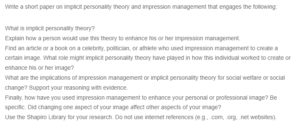Implicit Personality Theory and Impression Management
Implicit personality theory is the theory that explains the ideas that people form about others after learning and identifying some of their traits—for instance, concluding that a quiet person is polite. In other words, it explains that people tend to form impressions about others (Turska, 2020). Turska (2020) illustrates this theory by explaining that if an individual were to meet somebody for the first time, there is an opinion that the person will form about this individual they have met for the first time. However, it is important to note that these formed opinions are based on very limited information. Most importantly, the impressions one forms about the individual one has met are impacted by biases, assumptions, and other patterns that influence the assumptions that one makes.
Impression management is the process of directing how one forms impressions of others. Therefore, implicit personality theory helps one identify, understand, and be careful of the factors influencing how they form perceptions about others (Roulin & Bourdage, 2017). For instance, someone can conclude that individuals who use complex words and are dressed in suits are learned people. Hence, implicit personality theory helps one develop an awareness of these factors that influence one’s ability to form perceptions so that one can use them appropriately or even eliminate the wrong impressions that one has towards others (Roulin & Bourdage, 2017). The outcome of using this theory is that even though a person will make impressions of others, they are likely to make impressions that are devoid of biases. Hire our assignment writing services in case your assignment is devastating you.
Ellen Pompeo is an American actress known for taking a lead role in the Grey’s Anatomy series. In a magazine dated June 2020, the actress was reported to be among some of the residents who participated in the “take a knee” protest against racial injustice. The celebrity was part of a group of other residents in Los Angeles who were participating in a peaceful protest calling for justice and accountability (VanHoose, 2020). In this case, Impression management is seen in Ellen’s choice to also ‘take a knee’ to create that image to the public that she is against racism (Al-Shatti and Ohana, 2021). Implicit personality theory influenced her understanding that she could only show solidarity and speak loudly against racial injustice by doing what the general public was doing. In this case, ‘take a knee’ was the most popular and best impression she could use (VanHoose, 2020). Therefore, through participating in the protest and dressing in white, along with her decision to kneel on one knee with the rest of the protesters, she showed that some White people in higher places are also against racism.
When it comes to social implications, it is evident from the work of Al-Shatti and Ohana (2021) that impression management enables people to do so. It gives them the creativity to create a specific public perception and image. The benefit of this is that it helps one obtain a favorable public and social appearance in some cases. In other words, a person must be able to alter or falsify their persona to fit in society and for the welfare of society. For instance, suppose a friend invites a person to the funeral of his friend’s relative, where people are crying and mourning. In that case, the invited friend will also cry and mourn with his friend for their loss to fit in that social environment. This benefits society since it enhances social welfare.
I remember a time when I helped children in the community with their studies. Even though I had just finished high school and, as a teenager, I longed to dress like the others, I maintained a serious demeanor in the company of the children. I also dressed in official clothes to look very much like a teacher. Through this impression management, I encouraged them to take their studies seriously and look up to me as their teacher and mentor. Changing one aspect of my image affected other aspects of my image. For instance, I was a young man and desired to dress and behave like others, but that could not happen most of the time. I had to behave like an adult most of the time.
References
Al-Shatti E & Ohana M (2021) Impression Management and Career Related Outcomes: A Systematic Literature Review. Front. Psychol. 12, 701694. doi:10.3389/fpsyg.2021.701694
Roulin, N., & Bourdage, J. S. (2017). Once an impression manager, always an impression manager? Antecedents of honest and deceptive impression management use and variability across multiple job interviews. Front. Psychol. 8 (29). doi: 10.3389/fpsyg.2017.00029
Turska, D. (2020). Implicit Personality Theories (Ipts) and the Dispositionism of Teachers with Varied Teaching Experience. Educational psychology. DOI:10.14656/PFP20200301
VanHoose, B. (2020). Grey’s Anatomy Stars Ellen Pompeo and T.R. Knight Take a Knee Together During L.A. Protests. People Magazine. Retrieved from https://people.com/tv/greys-anatomy-stars-ellen-pompeo-and-t-r-knight-take-a-knee-during-l-a-protests/.
ORDER A PLAGIARISM-FREE PAPER HERE
We’ll write everything from scratch
Question
Write a short paper on implicit personality theory and impression management that engages the following:

Implicit Personality Theory and Impression Management
What is implicit personality theory?
Explain how a person would use this theory to enhance his or her impression management.
Find an article or a book on a celebrity, politician, or athlete who used impression management to create a certain image. What role might implicit personality theory have played in how this individual worked to create or enhance his or her image?
What are the implications of impression management or implicit personality theory for social welfare or social change? Support your reasoning with evidence.
Finally, how have you used impression management to enhance your personal or professional image? Be specific. Did changing one aspect of your image affect other aspects of your image?
Use the Shapiro Library for your research. Do not use internet references (e.g., .com, .org, .net websites).

